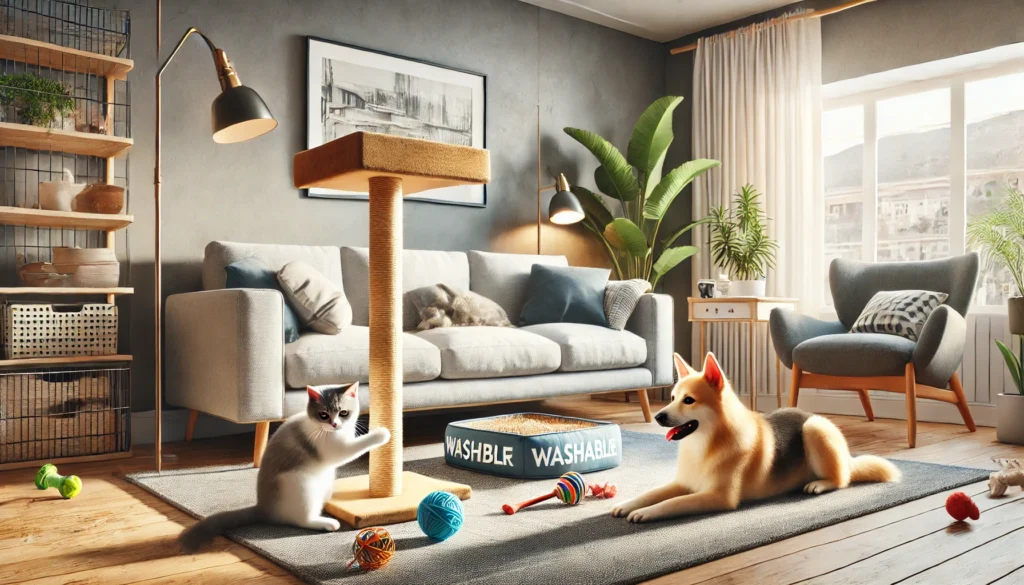Your pet may be adorable, but scratched-up couches, chewed chair legs, and shredded curtains can make coexisting with them a challenge. Fortunately, it’s absolutely possible to stop your dog or cat from destroying your furniture — without punishment or frustration. The key is understanding why they act this way and providing alternatives that fulfill their needs.
Let’s dive into practical, pet-friendly strategies to preserve your furniture and maintain peace at home.
Understand the Behavior Behind the Damage
Dogs:
Dogs often chew on furniture because they’re bored, anxious, teething (in puppies), or simply full of energy.
- Teething: Puppies chew to soothe sore gums.
- Boredom: Dogs left alone for long periods need an outlet.
- Separation anxiety: Chewing becomes a stress response when they’re left home alone.
Cats:
Cats scratch to sharpen claws, mark territory, or stretch their muscles. It’s instinctual, not malicious.
- Marking: Cats have scent glands in their paws.
- Exercise: Scratching is also a physical and emotional release.
- Preference: Certain textures attract cats more than others.
Provide Better Alternatives
If you want pets to stop targeting your furniture, you need to offer them something better.
For Dogs:
- Chew toys: Durable rubber toys, frozen treat-stuffed bones, and textured chews are great distractions.
- Rotating toys: Switch them out weekly to keep interest high.
- Interactive puzzles: Keeps their minds busy and reduces destructive tendencies.
For Cats:
- Scratching posts: Place them near the furniture they usually scratch. Vertical and horizontal options are ideal.
- Cat trees: These provide climbing, lounging, and scratching all in one.
- Cardboard scratchers: Affordable and often preferred by cats over furniture.
Use Positive Reinforcement
Training your pet is more effective when you reward good behavior rather than punish bad ones.
- Reward them: Give treats or affection when they use their toys or posts.
- Redirect gently: If they go for the furniture, interrupt and guide them to the correct object.
- Be consistent: Mixed signals confuse pets. Always praise the correct behavior.
Make the Furniture Less Appealing
Sometimes, making your furniture undesirable is the quickest way to stop the damage.
For Dogs:
- No chew sprays: Bitter apple or citrus sprays are safe and effective deterrents.
- Block access: Use baby gates or rearrange furniture to restrict problem areas.
- Remove temptation: Clean up food smells or crumbs that might be attracting them.
For Cats:
- Sticky tape: Cats dislike the texture of double-sided tape on furniture edges.
- Aluminum foil or plastic covers: Temporarily use these on the arms of sofas or chairs to discourage scratching.
- Scent deterrents: Citrus scents can turn cats away from certain spots.
Keep Their Environment Stimulating
A bored pet is a destructive pet. Offering mental and physical stimulation will drastically reduce unwanted behavior.
- Daily playtime: Interactive play burns energy and builds trust.
- Walks for dogs: Regular outings reduce anxiety and hyperactivity.
- Window perches for cats: Watching birds or traffic keeps them entertained.
Maintain Grooming and Health
Sometimes pets scratch or chew due to discomfort.
- Nail trims: Keep their claws short to minimize damage and reduce the urge to scratch excessively.
- Dental care: Dogs may chew to ease dental pain, so offer dental chews and get regular vet checks.
- Health check-ups: Rule out parasites or skin conditions that might cause excessive chewing or scratching.
Create a Pet-Friendly Zone
Designate a space in your home just for them.
- Comfortable beds: Place cozy spots in areas they like to rest.
- Play areas: Fill it with toys, scratchers, or puzzle feeders.
- Calm environment: Especially important for anxious pets prone to destructive behavior.
Stay Patient and Consistent
Breaking habits takes time — especially for adult pets who’ve had years of unrestricted access to furniture.
- Avoid yelling or physical punishment: It only increases stress and may worsen the behavior.
- Stick to routines: Predictability builds trust and reduces anxiety.
- Celebrate small wins: A day without scratches or chews is progress!
Consider Professional Help if Needed
If the destruction continues despite your best efforts, consult:
- Veterinarians: To rule out medical issues.
- Animal behaviorists: For customized behavioral plans.
- Certified trainers: Especially useful for anxiety-based destruction in dogs.
Final Thought: Your Home Can Be Pet-Friendly and Intact
You don’t have to choose between loving your pet and loving your furniture. With the right combination of redirection, training, and environmental adjustments, your dog or cat can thrive — and your sofa can survive.
Patience, empathy, and consistency are your best tools. Give them what they need, and they’ll give you the peace (and clean furniture) you deserve.






